Adrenal Cortical Carcinoma
A 31-year-old male, recently on active duty in the military, presents to the ER with approximately one- week history of abdominal bloating, early satiety, and back pain. The patient has recently returned from overseas duty in Iraq, but otherwise has had no other significant travel history. On specific questioning, the patient reports he has “probably been exposed to toxic chemicals.” The patient is otherwise in healthy condition, and denies recent surgery, or illness, and takes no medication. He admits to social alcohol use only, and denies IV drug abuse.
CLINICAL HISTORY
A 31-year-old male, recently on active duty in the military, presents to the ER with approximately one- week history of abdominal bloating, early satiety, and back pain. The patient has recently returned from overseas duty in Iraq, but otherwise has had no other significant travel history. On specific questioning, the patient reports he has “probably been exposed to toxic chemicals.” The patient is otherwise in healthy condition, and denies recent surgery, or illness, and takes no medication. He admits to social alcohol use only, and denies IV drug abuse.
FINDINGS
On exam, the ER physician noted a distended, non-tender abdomen and a markedly enlarged liver, with dullness to percussion. The patient’s laboratory data was unremarkable, and there was no elevated WBC. There was no hematuria, nor blood in the stool. A CT of the abdomen and pelvis was ordered.
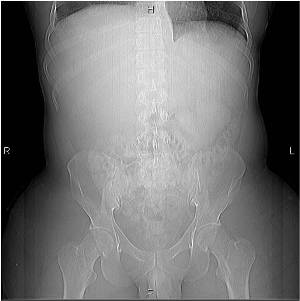
Fig. 1: Scout tomogram; prior to the initiation of the CT exam: Supine tomogram demonstrates an enlarged liver silhouette
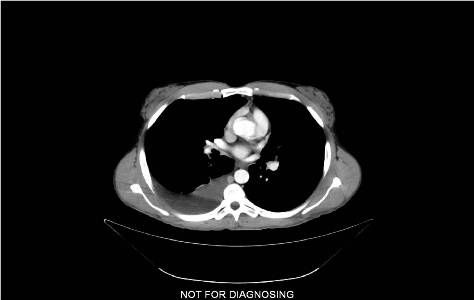
Fig. 2: Contrast enhanced axial CT image of the lung bases demonstrates a right pleural effusion and gynecomastia
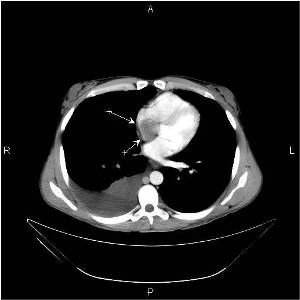
Figure 3: Contrast enhanced axial CT image demonstrates the presence of a right pleural effusion and a hypodense filling defect within the right atrium (arrows)
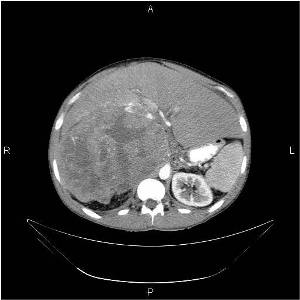
Figure 4: Contrast enhanced axial CT image demonstrates a large, enhancing right suprarenal mass
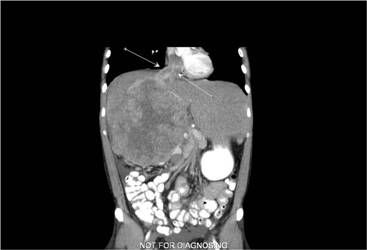
Figure 5: Contrast enhanced coronal reformatted CT demonstrates liver invasion and extension of disease into the supra-hepatic IVC, and right atrium (see arrows)
DIAGNOSIS
A CT-guided biopsy of the right adrenal mass was performed. Cytology revealed the mass to be an adrenal cortical carcinoma. An echocardiogram was also performed to confirm the CT findings of the tumor growing into the right atrium. Overall, LV function was preserved, and after discussion of the risks of embolization and thrombogenesis, it was decided that the patient should be referred to a tertiary care hospital for cardiothoracic surgical evaluation for possible removal of the tumor from the heart.
DISCUSSION
Adrenal cortical carcinoma is an extremely rare malignancy - approximately one to two per million per year. It usually affects adults, with a median age of 44. There is a 2.5-3.0:1, female to male predilection. Only about 30 percent are confined to the adrenal gland at the time of diagnosis, which translates to a grim prognosis. The overall five-year survival is 40 percent, with complete curative resection with radical surgery. Stage 4 disease, as in this case, has only a nine-month survival. CT and MRI are the imaging modalities of choice for diagnosis. Role of PET/CT is unclear due to the rarity of these tumors.
References
WebMD
Icard P, Chapuis Y, Andreassian B, et al: Adrenal Cortical Carcinoma in Surgically Treated Patients; a Retrospective study of 156 cases. Surgery 112 (6): 972-9.
Luton, JP et al: Clinical Features of Adrenal Cortical Carcinoma, prognostic features, and the effects of Mitotane Therapy. NEJM 322 (17): 1195-201. 1990.
Brennan, MF: Adrenal Cortical Cancer. CA Cancer Journal Clin. 37 (6). 348-65; 1987 Nov-Dec.
Dr. Spitzer is associate director of radiology at Montgomery Hospital in Norristown, PA. He can be reached at lspitzer@mont-hosp.com.










